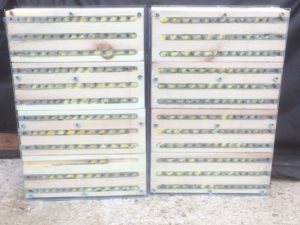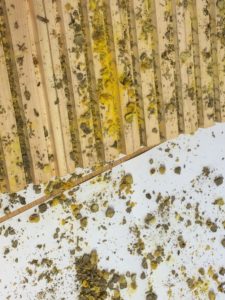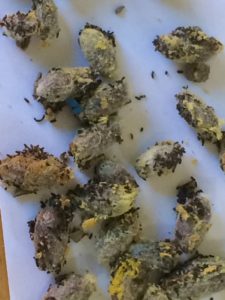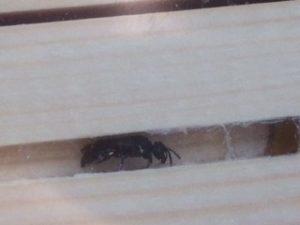As part of our ongoing support for the All Ireland Pollinator Plan, Castletown began a pilot project in 2019. Its aims were:
1: To educate our visitors about the value, importance and life cycle of our solitary mason bees.
2: To manage our red mason bee population and increase the number of female bees.
3: To harvest cocoons and offer them to educational organisations for research.
4: To identify what other species are present so as to be better able to manage our site for wildlife.
This infographic from The National Biodiversity Data Centre shows the life cycle of the solitary bee.
Early in the year, the project began with Head Gardener Rory Finnegan installing bee boxes in select places across the grounds. The aim was to encourage solitary bees to breed in these boxes.
Two boxes were installed on the wall of the West Wing, beside the café entrance. This is what they looked like:
This location was picked as we knew that bees were already living and breeding in the old masonry here. On a sunny day, you can see the busy bees flying in and out.
In May, mason bees colonised the bee box. Female bees laid eggs in one of the channels and left a supply of pollen as food for the egg, and sealed up the food and egg with a little bit of clay. Then the same female repeated the process and laid 12-15 eggs in the same channel.
The boxes filled up quickly and the box inserts were removed at the end of June and stored safely until Autumn when they had transformed from egg to larva to adult bee in their own cocoon.

Filled box inserts
In November, the cocoons were scraped out, and the cocoons were cleaned of pollen, poo and mites. The silk cocoons were then dried and placed in storage in a fridge.
The boxes and inserts were fully cleaned and sterilised to ensure the health of next year’s bee population.

The box inserts during cleaning
Over 200 cocoons were collected across the site! Some of these have been sent to Trinity College, Dublin and to The National Botanic Gardens, Glasnevin for educational and research projects.
While the mason bee inserts were in storage, Rory put in other inserts with different sized channels from 2mm to 6mm diameter designed to accommodate other types of solitary bee species so we could see what else was on site.
Here is some of what we did find:
The boxes will be reinstalled in the coming weeks, ready for use by Castletown’s bees again!
And why are bees so important?
Bees are one of the most important pollinators we have in Ireland. In order for plants to make a seed, and food for us humans, they need pollen. Bees and other insects move this pollen around for them. Baby bees eat pollen and when you see bees buzzing around the flowers in your garden, they are collecting pollen for their babies to eat and nectar for the adult bees to eat. While doing this, they collect and drop pollen onto the flowers they are collecting from. And when a plant gets some pollen from the same type of plant, it can make a seed to make new plants, some of which will be the fruits and vegetables that we humans need to eat. But don’t worry, these plants make lots and lots of pollen so there is plenty for them and for the baby bees!
We can help these busy little pollinators by making sure that we make lots of food available for them. Plant lots of flowers that will flower at all times of the year so that they always have a supply of food.
Please don’t use bee hotels or insect hotels. These seem like a great idea but in reality, they can cause disease as mites and fungi build up in them and make the bees sick.
Don’t use chemical pesticides on your plants. These make bees sick and some are fatal for bees.
Leave a strip or patch of grass uncut in your garden. Bees really love our native wildflowers like dandelions and leaving an area uncut can really help boost their food supply. You can find more information on how you can create a wildflower area on the All Ireland Pollinator Plan website www.pollinator.ie
You can also help by logging bee sightings on the Pollinator Plan website so that the experts can keep an eye on populations across Ireland.
And lastly, don’t be afraid of these little pollinators! Solitary bees are really unlikely to sting you. The male bees don’t have a sting and the females only sting in defence so if they are left alone to do their very important work, they will leave you alone!
Text and pictures by Sandra Murphy, Head Guide, and Rory Finnegan, Head Gardener, Castletown House







